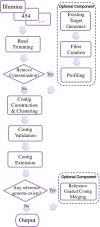De novo assembly of highly diverse viral populations
- PMID: 22974120
- PMCID: PMC3469330
- DOI: 10.1186/1471-2164-13-475
De novo assembly of highly diverse viral populations
Abstract
Background: Extensive genetic diversity in viral populations within infected hosts and the divergence of variants from existing reference genomes impede the analysis of deep viral sequencing data. A de novo population consensus assembly is valuable both as a single linear representation of the population and as a backbone on which intra-host variants can be accurately mapped. The availability of consensus assemblies and robustly mapped variants are crucial to the genetic study of viral disease progression, transmission dynamics, and viral evolution. Existing de novo assembly techniques fail to robustly assemble ultra-deep sequence data from genetically heterogeneous populations such as viruses into full-length genomes due to the presence of extensive genetic variability, contaminants, and variable sequence coverage.
Results: We present VICUNA, a de novo assembly algorithm suitable for generating consensus assemblies from genetically heterogeneous populations. We demonstrate its effectiveness on Dengue, Human Immunodeficiency and West Nile viral populations, representing a range of intra-host diversity. Compared to state-of-the-art assemblers designed for haploid or diploid systems, VICUNA recovers full-length consensus and captures insertion/deletion polymorphisms in diverse samples. Final assemblies maintain a high base calling accuracy. VICUNA program is publicly available at: http://www.broadinstitute.org/scientific-community/science/projects/viral-genomics/ viral-genomics-analysis-software.
Conclusions: We developed VICUNA, a publicly available software tool, that enables consensus assembly of ultra-deep sequence derived from diverse viral populations. While VICUNA was developed for the analysis of viral populations, its application to other heterogeneous sequence data sets such as metagenomic or tumor cell population samples may prove beneficial in these fields of research.
Figures


References
-
- Henn MR, Boutwell CL, Charlebois P, Lennon NJ, Power KA, Macalalad AR, Berlin AM, Malboeuf CM, Ryan EM, Gnerre S, Zody MC, Erlich RL, Green LM, Berical A, Wang Y, Casali M, Streeck H, Bloom AK, Dudek T, Tully D, Newman R, Axten KL, Gladden AD, Battis L, Kemper M, Zeng Q, Shea TP, Gujja S, Zedlack C, Gasser O. et al.Whole Genome Deep Sequencing of HIV-1 Reveals the Impact of Early Minor Variants Upon Immune Recognition During Acute Infection. PLoS Pathogens. 2012;8(3):e1002529. doi: 10.1371/journal.ppat.1002529. - DOI - PMC - PubMed
-
- Herbeck JT, Rolland M, Liu Y, McLaughlin S, McNevin J, Zhao H, Wong K, Stoddard JN, Raugi D, Sorensen S, Genowati I, Birditt B, McKay A, Diem K, Maust BS, Deng W, Collier AC, Stekler JD, McElrath MJ, Mullins JI. Demographic processes affect HIV-1 evolution in primary infection before the onset of selective processes. J Virol. 2011;85(15):7523–7534. doi: 10.1128/JVI.02697-10. - DOI - PMC - PubMed
Publication types
MeSH terms
Grants and funding
LinkOut - more resources
Full Text Sources
Other Literature Sources

